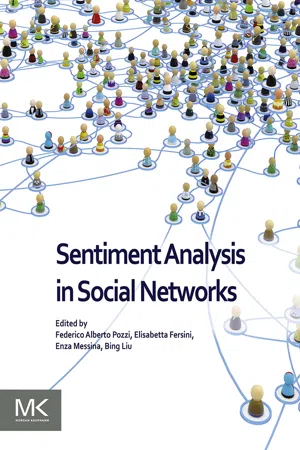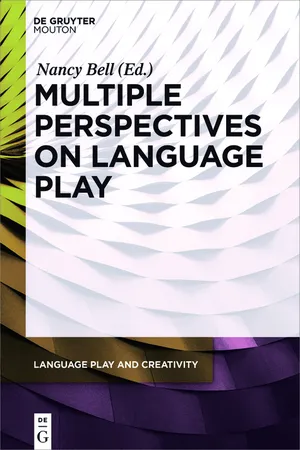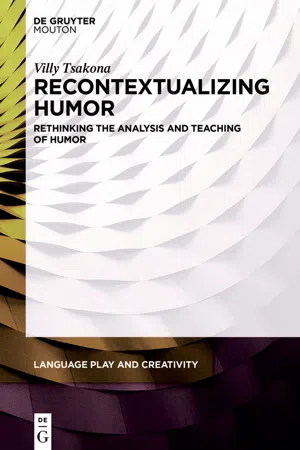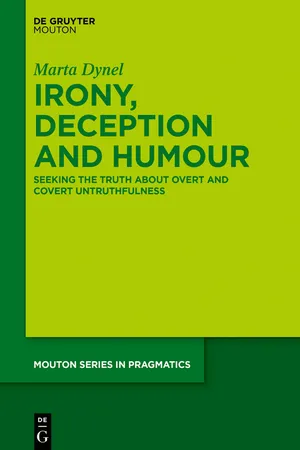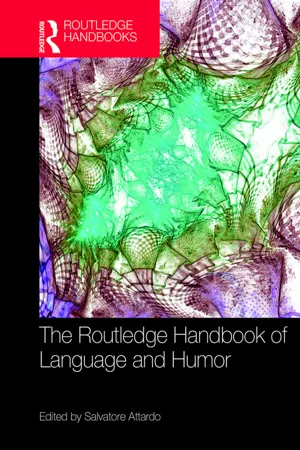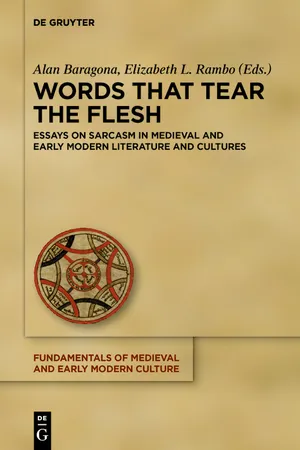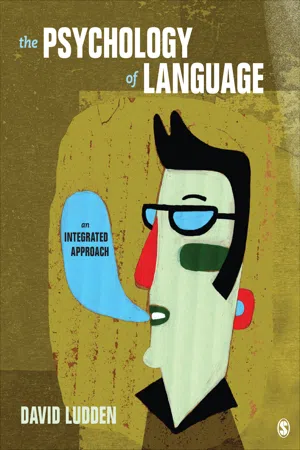Languages & Linguistics
Sarcasm
Sarcasm is a form of verbal irony that involves saying the opposite of what is meant, often with a mocking or contemptuous tone. It is used to convey humor, criticism, or disdain, and relies on the listener's ability to recognize the discrepancy between the literal meaning of the words and the intended meaning. Sarcasm is a common feature of everyday language and communication.
Written by Perlego with AI-assistance
7 Key excerpts on "Sarcasm"
- eBook - ePub
- Federico Alberto Pozzi, Elisabetta Fersini, Enza Messina, Bing Liu(Authors)
- 2016(Publication Date)
- Morgan Kaufmann(Publisher)
figurative language .Irony and Sarcasm are two interesting and strongly related concepts. Usually people do not have a clear idea of what they are. However, from early childhood we begin to use them in our daily life. They have been a topic studied by different disciplines, such as linguistics, philosophy, psychology, psycholinguistics, cognitive science, and recently computational linguistics. Each discipline has tried to define what they are, how they are produced, and why they are used.These figurative devices give us the opportunity to explore the interaction between cognition and language. Broadly speaking, irony and Sarcasm are figurative language devices that serve to achieve different communication purposes. The commonest definition of irony refers to an utterance by which the speaker expresses a meaning opposite that literally said. There are different theories that attempt to explain what irony is. Grice’s theory [1 ] points out that the speaker intentionally violates the “maxim of quality” (the speaker does not say what he or she believes to be false) when he or she expresses an ironic utterance. Some theories such the one described in [2 ] propose define it beyond the literal sense of the words: for Wilson and Sperber [2 ] an ironic utterance is an “echoic mention” that alludes to some real or hypothetical proposition to demonstrate its absurdity. Attardo [3 ] considers an ironic utterance as a form of “relevant inappropriateness” in which the speaker relies on the ability of the listener to reject the literal meaning on the basis of the disparity between what is literally said and the context in which it is said. On the other hand, the “failed expectation” intention (ie, the speaker’s approval or disapproval of the entity or situation at hand) behind an ironic expression has been studied by Utsumi [4 ] and Kumon-Nakamura and Glucksberg [5 - eBook - ePub
- Nancy Bell, Nancy Bell(Authors)
- 2016(Publication Date)
- De Gruyter Mouton(Publisher)
Sarcasm is a cultural phenomenon ubiquitous in contemporary societies. People use Sarcasm to achieve various communicative goals. Some use it to show their negative or positive attitudes (see Kim 2014:193 for an outline), while others use it to skillfully hide their emotion and intent (Giora, 2004; Ekman, 1984). In using and comprehending Sarcasm, speakers of English consider particular types of linguistic signals such as visual, prosodic, lexical, and contextual cues that exist within the conventions of the society. Particularly in the U.S., sarcastic characters are easily found in numerous scripted and unscripted television shows.Achieving conceptual understanding of Sarcasm in another languaculture (Agar, 1994) is no easy matter. It requires examination of the motivation, intensity, means of expression, and goals of Sarcasm in that particular culture. Mere exposure to the target language setting or having already achieved high proficiency in the language does not guarantee that learners will gain this ability. Bouton’s (1999) study on the second language (L2) acquisition of irony also disproves any co-relation between learners’ language proficiency and irony comprehension.Despite the need for instruction, teaching learners how to understand Sarcasm in L2 English is an under-researched area in applied linguistics. This problem originates partly from the fact that the ambiguous nature of Sarcasm makes the concept difficult to concretize into a tangible form and a teachable unit. Developing learners’ understanding of this complex concept requires an intervention carefully designed with theoretical and empirical rigor.This chapter reports on Kim’s study (2013) that introduces an innovative pedagogical approach for teaching the concept of Sarcasm to L2 learners. In particular, this chapter provides a complementary account of learners’ concept development by tracing the trajectories of learner knowledge prior to and after a particular form of instruction referred to as Systemic-Theoretical Instruction (STI). To show evidence of development, this chapter documents three major stages of learner growth: learners’ pre-understanding prior to STI, learner-teacher dialectics during STI, and learners’ communicated thinking as evidenced through verbalization data collected after STI. - eBook - ePub
Recontextualizing Humor
Rethinking the Analysis and Teaching of Humor
- Villy Tsakona(Author)
- 2020(Publication Date)
- De Gruyter Mouton(Publisher)
Such a comparison indicates that “the label ‘irony’ is typically used with reference to situational irony, whereas ‘Sarcasm’ denotes the presence of the rhetorical figure [of irony]” (Dynel 2017 : 84). Moreover, “contrary to the prevalent view in the scholarly literature that Sarcasm (…) promotes disharmony and conflict or is simply offensive”, in the data examined it appears to be “perfectly innocuous” and “carries no (intended or perceived) aggression” (Dynel 2017 : 84). Needless to say, this line of research could bring to the surface more such intriguing mismatches between emic and etic understandings of humorous phenomena, that is, between speakers’ metapragmatic stereotypes on humorous phenomena and the respective theoretical approaches and scholarly definitions of them. Studies in the lexical field of the word humor could also be considered part of its metapragmatic research. Hempelmann (2017) offers a detailed discussion of the meanings of terms such as humor, wit, laughter, comic, smile, amusement, and exhilaration mostly in English but also in other European languages such as German, French, and Spanish (see also the references therein). His suggestions align with previous research on the terminology of other pragmatic phenomena (e.g. politeness; see Culpeper 2011 : 74; Kádár and Haugh 2013 : 189–194; Culpeper and Haugh 2014 : 263) to the effect that there usually are significant differences in the meanings and uses of such terms not only across languages and cultures, but also within the same language due to polysemy and/or language change in time. As already mentioned (see Section 2.3), the use of such terms is always culture–specific and context–dependent, hence generalizations across contexts, languages and/or cultures could prove confusing and misleading - eBook - ePub
- Marta Dynel(Author)
- 2018(Publication Date)
- De Gruyter Mouton(Publisher)
Long and Graesser 1988; Gibbs and O’Brien 1991; Barbe 1995; Gibbs 2000; Caucci and Kreuz 2012). Sarcasm is thus perceived as the “crudest” form of irony (Muecke 1969: 20) or “an especially negative form of irony” (Gibbs 1994: 384). Gibbs seems to acknowledge that irony and Sarcasm are independent notions when he states that “it is possible to make sarcastic remarks without being ironic” but also claims that “most Sarcasm uses irony to get its bitter or caustic effect” (1994: 108). 82 Based on a dictionary definition, Gibbs states that “Sarcasm depends for its effect on bitter, caustic, and other ironic language that is usually directed against an individual” (1994: 108, italics added). Haiman espouses a belief that the essential feature of Sarcasm “is that it is overt irony 83 intentionally used by the speaker as a form of verbal aggression” (1998: 21, italics in original). The goal of this aggressive irony is to deprecate or even ridicule the victim (see Kreuz and Glucksberg 1989; Lee and Katz 1998; Channon et al. 2005; Shamay-Tsoory et al. 2005; Bowes and Katz 2011). Supportive of the assumption of the aggressive nature of Sarcasm, a few authors explicitly ascribe meaning opposition (typically associated with standard irony) to Sarcasm. For example, Haiman (1990: 181) claims that a sarcastic speaker “intends to mean the opposite of what his message would normally mean”. Similarly, Rockwell writes that “both Sarcasm and irony describe utterances that express the opposite of the speaker’s true intent” (2006: 6) and conceptualises Sarcasm as a subtype of irony, “a sharply mocking or contemptuous ironic remark intended to wound another” (2000: 485). For their part, Leggitt and Gibbs (2000: 5) propose that Sarcasm “clearly contradicts the knowable state of affairs”, which irony does as well. Leggitt and Gibbs (2000) see Sarcasm as more pointed and critical than irony but differentiate between the two also depending on who an utterance is critical of - eBook - ePub
- Salvatore Attardo(Author)
- 2017(Publication Date)
- Routledge(Publisher)
Among many of these are Sarcasm, ironic praise, ironic criticism, hyperbole, understatement, ironic analogy, and ironic restatement. Still other forms are also considered parallel or similar to verbal irony but reside outside of irony accomplished through language per se, although language can certainly be involved. Some examples of this set are satire, parody, visual irony, and hypocrisy. In the interest of brevity only the former instances will be treated at length here. Many, although not all, forms of irony enable management of negativity expression issues (Colston, 2015). Sarcasm, as a form of verbal irony is arguably most strongly associated with this negativity expression. Sarcasm is generally considered a nasty, mean-spirited or just relatively negative form of verbal irony, used on occasion to enhance the negativity expressed relative to direct, non-figurative criticism (Colston, 1997). It may also afford a nuanced expression of negativity by tinging the level of criticism expressed (Dews & Winner, 1995; Dews et al., 1995). In either instance, though, its purpose is to successfully convey a speaker’s desired level of negative attitude about some referent event/situation. Some have argued that Sarcasm is the most prevalent form of verbal irony (Capelli et al., 1990). Others have noted independently that this negativity expression management seems the primary function of verbal irony (Roberts & Kreuz, 1994; Colston, 2015). It thus makes sense that Sarcasm and negativity management coincide. Ironic criticism and ironic praise (the latter sometimes called ironic compliment) are terms used to discern between a speaker’s expression of negativity by uttering something seemingly positive (e.g., “Nice stain you’ve got there”), vs. positive expression through seemingly negative utterances (e.g., “You raging psychopath!,” said to someone acting kindly). This distinction is important because measurable differences between the forms are easily obtained - eBook - ePub
- Stephen Alan Baragona, Elizabeth Louise Rambo, Stephen Alan Baragona, Elizabeth Louise Rambo(Authors)
- 2018(Publication Date)
- De Gruyter(Publisher)
hijā ʾ). The concluding remarks offer a tentative thesis as to why Sarcasm was not widely discussed despite its recognition as a mode of speech.Reading Sarcasm: The Problem of Speech and para-textual Evidence
The attentive reader will object that I have thus far avoided specifying what I mean by Sarcasm. As is also the case with comedy writ large, the articulation of a universal definition has proven elusive yet desirable.266 To properly undertake this challenge, a number of concerns need to be addressed. I offer here a systematic method for analyzing sarcastic remarks in texts to avoid adding to the irreproducible or purely subjective claims that are highlighted above. This method accounts for remarks stripped of the context clues that someone who is addressed verbally relies on to make such a determination, and enumerates some key concepts and terms related to identifying Sarcasm in Arabic texts.Sarcasm is foremost a restricted case of verbal irony, an allusive use of language. Verbal irony is, in turn, a speech act which identifies an is/ought dichotomy. Unlike situational irony, in which several elements are understood as juxtaposed by circumstance, verbal irony operates by what John L. Austin first termed “illocution”: the performance of intention and the acceptance of the performance’s consequences.267 This understanding bears a strong relation to the principle of tahakkum articulated by Ibn Abī Iṣbaʿ, in which the outward meaning of a speech act appears to be serious while the intention conveys and commits to a comic critique. Working from these propositions, Elisabeth Camp has attempted to harmonize competing analytical approaches of how best to judge the nature of a speaker’s illocutionary commitment to the is/ought discrepancy.268 Camp synthesizes the notions of verbal irony and illocution in order to produce “a workable analysis of Sarcasm”: “Sarcasm […] is speech which [1] presupposes a normative scale , which [2] pretends to undertake (or at least, evokes) a commitment with respect to this scale; and which thereby [3] communicates an inversion of this pretended (evoked) commitment.”269 - eBook - ePub
The Psychology of Language
An Integrated Approach
- David C. Ludden(Author)
- 2015(Publication Date)
- SAGE Publications, Inc(Publisher)
. Oftentimes verbal irony has a negative connotation, especially when it’s used to express frustration or disappointment in yourself or others (Pexman, 2008). For instance, you might mutter “Well that’s just wonderful” when you get a bad grade on an assignment, or you might say “That was smooth!” when a friend trips for no obvious reason. In these cases, the positive literal meaning is contradicted by the negative context. However, we can also use verbal irony to convey a positive intended meaning with words that have a negative literal meaning. This would be the case if your friend told you she just got an A on an exam and you replied, “That’s too bad.” Discourse analyses reveal that verbal irony is fairly common in casual conversation between friends, occurring on about 8% of turns.Sarcasm is the special case of verbal irony that is intended to criticize or ridicule another person (Scharrer & Christmann, 2011). In other words, not all irony is sarcastic, but all Sarcasm is ironic. Observational studies show that males make almost twice as many sarcastic remarks in ordinary discourse compared with females (Katz, Blasko, & Kazmerski, 2004). Listeners are also more likely to interpret a remark as sarcastic if it is made by someone in an occupation such as comedian or factory worker that’s stereotypically associated with Sarcasm, compared with remarks from teachers and clergy, who aren’t expected to use Sarcasm.Figure 12.5 Casual ConversationSource: ©iStockphoto.com/kali9.Verbal irony fulfills a number of social functions (Recchia et al, 2010). As we learned in Chapter 7 , people often communicate their intentions in indirect ways with the expectation that the listener will understand the underlying meaning. Polite requests like Could you pass the salt? and rhetorical questions like How many times do I have to tell you to stop?
Index pages curate the most relevant extracts from our library of academic textbooks. They’ve been created using an in-house natural language model (NLM), each adding context and meaning to key research topics.
Explore more topic indexes
Explore more topic indexes
1 of 6
Explore more topic indexes
1 of 4
